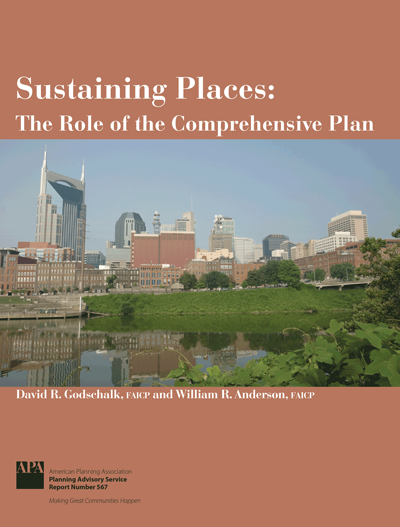Sustaining Places: The Role of the Comprehensive Plan
PAS Report 567
By David Godschalk, FAICP, William Anderson, FAICP

Not a member but want to buy a copy? You'll need to create a free My APA account to purchase.
Create account
Planning for sustainability is the defining challenge of the 21st century. More than any other single endeavor, it confronts the critical perils to our future, from energy shortages and environmental stress to climate shifts and population surges.
That's the argument of a forward-looking new report from the American Planning Association. In plain language, authors David R. Godschalk, FAICP, and William R. Anderson, FAICP, show how cities, towns, and regions can work together to meet the challenge. These leading planners put forward eight principles for developing comprehensive plans that address today's needs without compromising the needs of the next generation. Case studies demonstrate sustainability planning at work in cities including Seattle and San Diego and smaller communities like Keene, New Hampshire, and Union County, Pennsylvania.
Sustaining Places gives planners, local officials, and involved citizens a practical framework for understanding today's concerns and a roadmap for moving toward a better future. The report culminates the American Planning Association's multiyear, multifaceted Sustaining Places Initiative.
Table of Contents
Acknowledgments
Chapter 1: Introduction: Task Force Charge and Approach
Sustaining Places: Challenges and Opportunities
Process
Planning for Sustaining Places: A Working Definition
Characteristics of Plans for Sustainable Communities
Chapter 2: Principles for Planning for Sustaining Places
Implications for Planning Practice
Best Practice Principles for Sustaining Places Comprehensive Plans
Next Steps
Chapter 3: The Need for Sustainability in Cities and Regions
Sustainability Connections in Comprehensive Planning
Chapter 4: The Role and Status of the Comprehensive Plan in Sustaining Places
The Power and Scope of the Comprehensive Plan
Communities as Systems
Incorporating Sustainability into the Planning Process
The Content of the Plan
Chapter 5: Planning Scale and the Vertical Integration of Plans
The Regional Plan
The County Plan
The Rural Plan
The City Comprehensive Plan
The Community Plan
The Area Plan
The Plans Come Together
Chapter 6: Sustaining the Plan through Implementation
The Action Element
Monitoring the Plan
Updating the Plan
Adapting the Plan
Chapter 7: Conclusions and Recommendations: An Agenda for Sustaining Places
Making and Implementing Comprehensive Plans for Sustaining Places
Call to Action
Appendix A. Plan Reviews
Toward a Sustainable Seattle
Marin, California, Countywide Plan
Fort Collins, Colorado, 2011 City Plan
San Diego County -- The 2004 Regional Comprehensive Plan (RCP) for the San Diego Region
Keene, New Hampshire, 2010 Comprehensive Master Plan
Burlington, Vermont, 2000 Legacy Plan
Union County, Pennsylvania, "Cultivating Community" Comprehensive Plan
Draft of the Philadelphia 2035 Comprehensive Plan
Draft of the Albany, New York, 2030 Comprehensive Plan
Connecting Cleveland 2020 Citywide Plan
Appendix B. San Diego Regional Planning Program
Tier 1: The Regional Comprehensive Plan
Tier 2: General Plans of Local Jurisdictions
Tier 3: Community Plans
Tier 4: Master Plans
The Vertically Integrated Planning System
References


